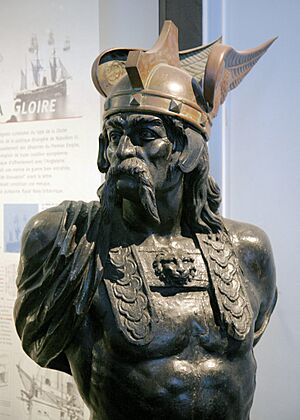Brennus (leader of the Senones) facts for kids
Brennus (also called Brennos) was a powerful leader of the Senones. This was a Gaulish tribe. He is famous for defeating the Romans at the Battle of the Allia around 390 BC. Later that same year, he led an army of Gauls from northern Italy to attack Rome. They captured most of the city and held it for several months. Brennus' capture of Rome was the only time in 800 years that the city was taken by a non-Roman army. This happened long before the city fell to the Visigoths in 410 AD.
Contents
Who Were the Senones?
The Senones were a Gaulish tribe. They originally came from parts of France that are now called Seine-et-Marne, Loiret, and Yonne. Over time, they moved and took over northern Italy. Around 400 BC, some of the Senones crossed the Alps mountains. They drove out another group called the Umbrians. Then, they settled on the east coast of Italy, from Ariminum to Ancona. This area was known as the Ager Gallicus. They founded a town called Sena Gallica (which is now Senigallia), and it became their main city.
In 391 BC, the Senones invaded a region called Etruria. They surrounded the city of Clusium. The people of Clusium asked Rome for help. Rome sent three brothers, including Quintus Fabius Ambustus, to talk with the Gauls. It is said that these Roman negotiators broke their promise to stay neutral. They supposedly joined in the fighting outside Clusium. Ancient writers like Livy and Plutarch say that the Senones then marched to Rome to get revenge for this.
Some historians believe that the whole story about Clusium might not be true. They think Clusium might not have needed Rome's help. Also, the Gauls might not have needed a special reason to attack Rome. This story might have been created to explain why Rome was attacked. It also made Rome look like a protector of Italy against the Gauls. Another idea is that Brennus might have been working with Dionysius of Syracuse. Dionysius wanted to control all of Sicily. Rome was allied with Messana, a small city in Sicily. If Rome's army was busy fighting Brennus, it would help Dionysius's plans.
The Gauls Attack Rome
In the Battle of the Allia, Brennus and his army defeated the Romans. After this victory, they entered the city of Rome itself. The Senones captured almost all of Rome. Only the Capitoline Hill was successfully defended against them. According to an old story, Marcus Manlius Capitolinus was warned about a Gaulish attack by the sacred geese of the goddess Juno.
Seeing their city destroyed, the Romans tried to buy their freedom from Brennus. They agreed to pay one thousand pounds of gold. The Roman historian Livy tells us that there was an argument about the weights used to measure the gold. The Gauls had brought their own weights, which were heavier than the Roman ones. Brennus then threw his sword onto the scales. He famously said, "Vae victis!" This Latin phrase means "woe to the conquered!" or "pity the defeated!"
Rome Fights Back
One version of the story says that the argument about the gold weights caused a delay. This delay gave the exiled Roman leader Marcus Furius Camillus enough time. He was able to gather an army and return to Rome. Camillus then drove out the Gauls, saving both the city and its treasury. He told Brennus, "Non auro, sed ferro, recuperanda est patria." This means, "not by gold, but by iron, is the nation to be recovered."
According to Plutarch, after some fighting in Rome's streets, the Gauls were first pushed out of the city. Then, they were completely defeated in a big battle eight miles outside of Rome. This battle happened on the road to Gabbi. Camillus was celebrated by his soldiers. They called him another Romulus, the "father of his country" ('Pater Patriae'), and the second founder of Rome.
Livy also mentions that the Senones who were surrounding the Capitoline Hill became sick. This made them weaker when they took the ransom from Rome. This is quite possible, as diseases like dysentery and other health problems have made many soldiers sick throughout history.
Brennus in Stories and Art
- Geoffrey of Monmouth's book Historia Regum Britanniae features Brennus under the name Brennius.
- A famous painting called Le Brenn et sa part de butin (1893) by Paul Jamin shows Brennus. It shows him looking at the spoils (things taken from the city) after Rome was looted.
- The ghost of Brennus appears in the play Fuimus Troes. He supports the Britons fighting against Julius Caesar.
- Brennus was played by Gordon Mitchell in the 1963 movie Brennus, Enemy of Rome.
- Brennus and the attack on Rome by the Senones are part of Steven Saylor's historical novel Roma (2007).
- Brennus is a leader you can play as for the "Celts" group in the 2001 video game expansion Civilization III: Play the World.
Images for kids
See also
 In Spanish: Breno (siglo IV a. C.) para niños
In Spanish: Breno (siglo IV a. C.) para niños



